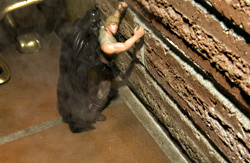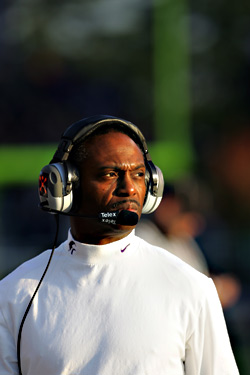Ever since the demonstrations against the World Trade Organization, many Seattleites have searched for the next landmark that would stand as symbol and signifier of relations between police and protesters. Last weekend may have been that landmark.
On March 22, peaceful Seattle protesters had their rights to free speech and free assembly stolen by the policeand afterward, the citys mainstream media let the police get away with the deed.
That day was the third in a series of permitted anti-war protests held at the Henry M. Jackson Federal Building in downtown Seattle. The two previous days had seen peaceful protests and well-behaved, permitted marches through downtown. In fact, since the local peace movement first began taking its views to the streets last fall, there have been marches of as many as 30,000 people at a time that have proceeded without incident.
But last Saturday was different.
Seattle police and the peace group Not in Our Name, which was organizing events at the Federal Building that day as it has previous peaceful marches, could not agree on terms for a permitted march. As a result, the group announced to protesters at the Federal Building that marching in the streets would result in arrest and that police would strictly enforce jaywalking regulations. Barred from the streets, about 400 of the 800 protesters present decidedin the loosely reasoned, word-of-mouth way favored by the leftto take their message of no war in Iraq to the sidewalks of downtown.
This was not an outwardly rowdy bunch, although police were convinced that the group wanted to march randomly through the city and stop traffic, according to Duane Fish, a police department spokesperson.
Sure, there were about 20 members of the anarchist Black Bloc floating around, but in the main, the crowd were your typical nonthreatening lefties.
And so they marched south along Second Avenue for three blocksnot impeding traffic, not jaywalking, not doing anything except expressing themselvesuntil about 40 riot cops cut them off at Cherry Street. The marchers were halted before they had barely acted. After several minutes of chanting from the sidewalks, the marchers headed north along First Avenue. At the intersection of Spring Street and First Avenue, the crowd was again cut off by dozens of police in riot gear. Here, police bottled up the marchers, refusing to let them cross the street and arresting those who tried. (The day resulted in 18 arrests.)
After 45 minutes, a wave of riot cops and officers on horseback swept down from the north, forcing marchers to head south on the sidewalks of First Avenue. Police would not allow protesters to return to the nearby Federal Building or to leave the march.
Eventually, police forced the 200 or so remaining marchers down to South Jackson Street near Pioneer Square.
There, the protesters stoodon the sidewalksfor approximately an hour, hemmed in by 300 very intimidating riot cops. No one was allowed to leave. Even innocent passersby were trapped by Seattles finest. Then police announced that everyone had five minutes to disperse from the sidewalks or face arrest. By this time, most protesters would have shined the cops badges if it had gotten them out of there faster. Still, despite the police announcement, cops would only let protesters leave in groups of two.
What with all its Kafka-esque elements, it was one of the strangest messes Ive seen in a long time.
Its also one that may well have been illegal.
If protesters are not creating an immediate hazard, even without a permit, I doubt that the government has the
right to corral folks and hold them, says John Strait, an associate professor of law at Seattle University. Government cannot interfere with the reasonable exercise of First Amendment freedoms. It can regulate time, place, and manner within public safety considerations, but that doesnt normally require shutting down a demonstration.
Let me be clear: Only once did I see protesters do anything that might be a threat to public safety. That happened when a few anarchists sprinted onto First Avenue for a moment. Thats not to say that protesters were angels. After being hemmed in by the cops, they were quite mad and several used the occasion to taunt the copsbut, of course, they did it from the sidewalk. And someone spray painted an anarchist symbol on the window of a First Avenue Starbucks.
I want to be clear about something else: This theft of the First Amendment went on right under the noses of Seattles media. They were all there: the Seattle Post-Intelligencer, The Seattle Times, KING-TV, KIRO-TV, KOMO-TV, and KCPQ-TV. Not one of them mentioned that protesters had been denied their rights to free speech and assembly or considered that police were overzealous in routing the crowd.
Youd think that a group of reporters, all highly dependent upon the First Amendment, would be a bit more sensitive to the gelding of free speech. But they arent the only timid ones.
The office of Mayor Greg Nickels refused to comment on Saturdays events, deferring all questions to the police. The police say that two elements taken togetherNot in Our Names refusal to get a march permit and police intelligence gathering that suggested the protests organizers wanted to block downtown trafficforced their hand.
Still that leaves me, a relative newcomer to this city, to wonder how this supposedly progressive-liberal city turned into one where the police get to decide to whom the First Amendment applies based upon what they think they know about a group before it even acts.









